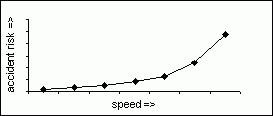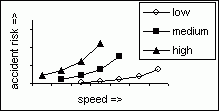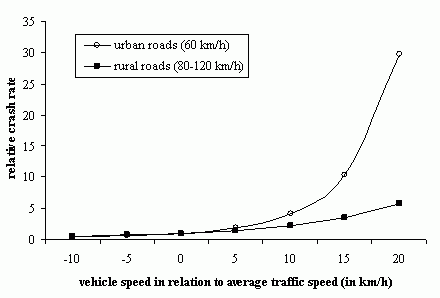A higher speed increases the likelihood of an accident. Very strong relationships have been established between speed and accident risk: The general relationship holds for all speeds and all roads, but the rate of increase in accident risk varies with initial speed level and road type. Large speed differences at a road also increase the likelihood of an accident. In addition, drivers driving much faster than the average driver have a higher accident risk; it is not yet evident that this is also the case for the slower driver.
Assessing potential effectiveness of speed reduction measures
Based on work by Nilsson in Sweden, a change in average speed of 1 km/h will result in a change in accident numbers ranging between 2% for a 120 km/h road and 4% for a 50 km/h road. This result has been confirmed by many before and after studies of different speed reduction measures. This relationship is used by other Scandinavian countries and by Australian and Dutch safety engineers.
A similar relationship is assumed in Britain, based on empirical studies by Taylor, where changes in accident numbers associated with a 1 km/h change in speed have been shown to vary between 1% and 4% for urban roads and 2.5% and 5.5% for rural roads, with the lower value reflecting good quality roads and the higher value poorer quality roads.
Higher speeds: more accidents
High speed reduces the possibility to respond in time when necessary. People need time to process information, to decide whether or not to react and, finally to execute a reaction. At high speed the distance covered in this period is longer. At high speeds the distance between starting to brake and a complete stand still is longer as well. The braking distance is proportional to the square of speed (v2). Therefore, the possibility to avoid a collision becomes smaller as speed increases. This is well illustrated at a broad average level by Finch.
1 km/hincrease in speed→ 3% increase in accidents
In practice the relationship is more complex. The exact relationship depends among many other things on speed level and road type.
The higher the speed, the steeper the increase in accident risk
The relationship between speed and accident risk is a power function: With increasing speed, the accident risk increases more as the absolute speed is higher.
Based on the principles of kinetic energy and validated by empirical data, Nilsson developed the following formula:
In words: the number of injury accidents after the change in speed (A2) equals the number of accidents before the change (A1) multiplied by the new average speed (v2) divided by the former average speed (v1), raised to the square power.
Also road type affects the relationship speed -accident risk
On some roads the traffic situation is more complex than on other roads. This depends for example on the number and type of intersections; the absence or presence of pedestrians, cyclists, agricultural vehicles. In more complex traffic situations, the accident risk is higher. In addition, the increase of accident risk is larger as complexity increases Taylor. An example of a low complexity road type is a motorway. An example of a high complexity road type is an urban arterial road.
Larger speed differences: more accidents
If on a particular road, the speed variance is high, this will result in less predictability, more encounters, more overtaking manoeuvres, etc. Therefore, when speed differences increase, the accident risk increases as well. Hence, a countermeasure that results in lower average speed, but in larger speed differences may not have the expected positive effect on road safety. But no reliable quantified relationship has been established for this linkage.
Higher accident risk for the faster driver
A number of studies looked at the risk of the individual driver in relation to speed. These studies compare the (estimated) speed of drivers who were involved in an accident with the average speed at that particular road. The first studies date from the 1960 and 1970s in the United States. They found the both the faster driver and the slower driver had a higher risk of being involved in an accident. This was known as the U-curve speed-accident relationship. More recent studies, mainly conducted in Australia and Great Britain also found a higher accident risk for the faster driver. However, they did not find evidence for a higher accident risk for the slower driver. As an example, the results of the Australian studies:
Relative accident rate on urban roads and rural roads for vehicles going faster and slower than average speed (=0).
The risk of speeding and drink-driving
Some authors have noted that the increased risk from driving at speeds 10-20% above the average for the road is similar to the increased risk from driving at the drink drive limits in the two countries to which the references relate (i.e. a BAC of 0.05 and 0.08). This is based on empirical research in Australia by Kloeden.
Australian research: the risk of speeding in comparison to drink driving risks
The Australian researchers Kloeden, McLean and colleagues performed a case control study to compare the risk of speeding and the risk of drink driving. In urban areas with a speed limit of 60 km/h, the researchers determined the speed of accident involved cars preceding the accident as well as the blood alcohol concentration (BAC) of the accident involved drivers. Similarly, they determined the speed and BAC of cars/drivers not involved in accidents, but driving in the same direction, same day of the week, same hour of the day, etc. They also controlled for other potentially confounding variables, such as age and gender. The risk of sober, non-speeding drivers was the basic risk, set at 1. The risk of speeders and drink drivers was determined relative to this basic risk. They found:
| Speed | Relative risk of speeding | Blood Alcohol concentration (g/dl) | Relative risk of Drink driving |
|---|---|---|---|
| 60 km/h | 1.0 | 0.00 | 1.0 |
| 65 km/h | 2.0 | 0.05 | 1.8 |
| 70 km/h | 4.2 | 0.08 | 3.2 |
| 75 km/h | 10.6 | 0.12 | 7.1 |
| 80 km/h | 31.8 | 0.21 | 30.5 |
This study indicates that exceeding the speed limit of 60 km/h by 5 km/h is comparable to the risk of a BAC of 0.05. The risk of exceeding the 60 km/h speed limit by 10 km/h is higher than driving with a BAC of 0.08.
Source: Kloeden et al., 1997




